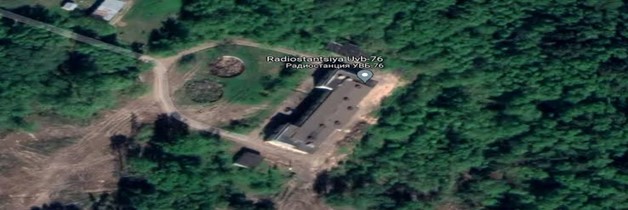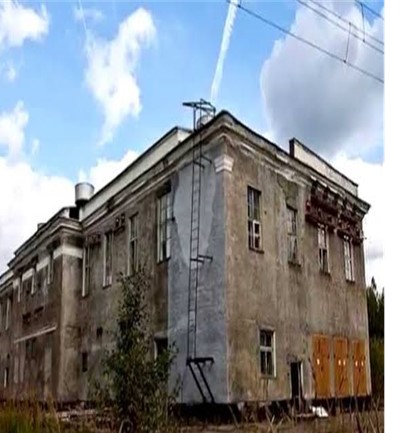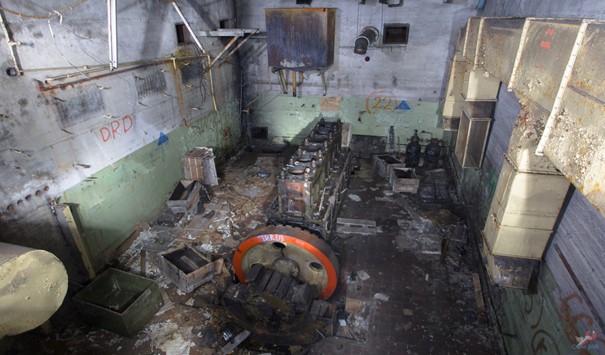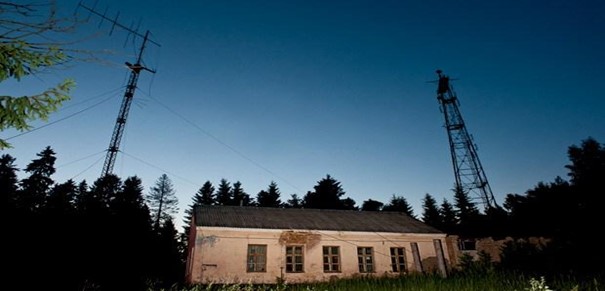We humans have always chased after the mysterious, the astonishing, the curiosity-stirring—and we have pursued it to the very end. However much it may frighten us, that blend of wonder and curiosity within us refuses to leave. In this piece, we, too, will speak of one of Russia’s most thrilling, unresolved enigmas: the Ghost Radio Station.

What Is UVB-76?
UVB-76, also known by the nickname “The Buzzer,” is a shortwave radio station broadcasting on 4625 kHz. It emits a short, monotonous buzzing tone—24 hours a day—repeating at roughly 25 tones per minute. At times the buzzing cuts off and a Russian voice transmission breaks in. The start date of its broadcast is disputed; allegedly it began in the late 1970s, most likely in 1976.
Where and When Did UVB-76 Emerge?
Not far from St. Petersburg, Russia, there is a rectangular iron gate standing in the middle of a marshy field. Beyond its rusted bars rise radio towers, derelict buildings, and power lines framed by a dry stone wall. The place shelters a secret reaching back to the most fevered days of the Cold War. It is believed to be the center of a radio called “MDZhB,” though no one knows who runs it. For the past 35 years—seven days a week, twenty-four hours a day—it has been broadcasting a droning, monotonous sound. Every few seconds another tone joins in, like a ghost ship’s foghorn, then the original buzz carries on. Once or twice a week, a male or female voice speaks in Russian—words like “agronomist” or “rubber boat.” And that is all. These occasional human voices raise doubts about whether someone is manning the station, yet since its current location is unknown, the truth has never been learned.
On June 5, 2010, it was reported that UVB-76 fell silent for about 24 hours, only to return to normal on the morning of June 6.
Wherever you are in the world, anyone who tunes a radio to 4625 kHz can listen to this broadcast. Anyone who tunes in can hear The Buzzer. As for the station’s mode: it transmits AM with a suppressed lower sideband (USB modulation), though it has also used full double-sideband AM (A3E). The signal consists of a humming tone lasting 1–2 seconds, pausing 1–1.3 seconds, and repeating 21–34 times per minute. Until November 2010, each buzz lasted about 0.8 seconds. One minute before the top of the hour the repeating tone was previously replaced by a continuous alternative tone—though this ended in June 2010, the short repeating buzz continued for a full minute before resuming its usual pattern.

Since it began in the 1970s, the buzzer sound shifted into a two-second repeating beep by the late 1980s/early 1990s. Briefly, on January 16, 2003, it changed to a longer, higher-pitched tone (about 20 tones per minute), but since then it has returned to its previous pattern. The length of the buzz has grown and deepened over time, and breakdowns have become more frequent—suggesting the sound may be mechanically produced. During a 2016 malfunction, one could hear a person striking a mechanical buzzer to get it running again—implying the transmissions are normally monitored around the clock.
UVB-76 and the Conspiracy Theorists
The station is so arcane it feels almost custom-made for conspiracy theorists. It has tens of thousands of followers who, affectionately, call it “The Buzzer.” As many admit, they do not know what they are listening to.
In truth, no one knows what the station does. David Stupples, an electronic intelligence systems expert at City, University of London, says, “There is no information in the signal.”
Is UVB-76 for a Nuclear Strike?
The frequency is thought to belong to the Russian military, though the military has never acknowledged it. The station began broadcasting toward the end of the Cold War, in a time when communism was waning.
Today it is said to broadcast from two separate points: this site near St. Petersburg, and an area close to Moscow. Strangely, rather than being shut down after the Soviet Union collapsed, its activity seemed to intensify.
The theories never end. Some claim its purpose is to maintain contact with submarines—or even to communicate with aliens. One theory holds that if Russia were ever attacked with nuclear weapons, the broadcast would cease and automatically trigger a retaliatory strike—ensuring that both the aggressor and the target obliterate one another with nuclear arms.

What Are the Features of the UVB-76 Signal?
This possibility is not as bizarre as it sounds. During the Soviet era, a system was developed to scan broadcast frequencies for signs of life—or traces of nuclear conflict. Known in the West as the “dead hand,” this system later evolved into a computer network that would trigger retaliation in the event of a nuclear strike. Worryingly, many experts believe it could still be in use.
As Vladimir Putin has stated, in a nuclear war between Russia and the United States “no one survives.” Might The Buzzer be meant to forestall such a possibility?
The signal itself offers hints. Like most international radio, The Buzzer uses the relatively low frequencies of shortwave. Compared with local radio, cellular, and television signals, the number of waves passing a given point each second is lower—allowing radio waves to travel far greater distances.
While you might struggle to hear a local station such as BBC London from a neighboring region, shortwave broadcasters like the BBC World Service can reach listeners from Senegal to Singapore—even when both stations share the same building.

UVB-76 and the Dead Hand Theory
When an affair is this mysterious and explanations never arrive, conspiracy theorists keep speculating—for years on end.
Some say UVB-76 connects with Russian intelligence agents across the globe; others insist it is the “Dead Man’s Hand” and that, under nuclear threat, the station would fall silent and automatically trigger retaliation.
As the “nuclear” debate continues between Russia and the rest of the world, UVB-76 seems destined to be discussed even more—and to keep its secret.
High-frequency radio signals travel in straight lines and vanish when they strike obstacles or reach the horizon. Shortwave signals, by contrast, can bounce off the charged particles in the upper atmosphere, zig-zagging between earth and sky to cover thousands of kilometers.
Which brings us back to the “Dead Hand.” Shortwave is, unsurprisingly, immensely popular—used today on ships and planes and for transcontinental military communications that cross seas and mountains.
There is, however, a caveat. Shortwave is like the ocean: it rises and falls. By day it climbs; by night it descends. If you want your broadcast heard on the far side of the world—especially if your aim is to signal nuclear war—you must change frequency according to the hour. The BBC World Service does this. The Buzzer does not.
Another idea is that the station is used to gauge how far away that layer of charged particles lies.
Another Station Resembling the UVB-76 Buzzer
Curiously, there was once another station much like The Buzzer. From the mid-1970s to 2008 it, too, could be heard on the other side of the world. Like The Buzzer, it broadcast from an undisclosed location—thought to be in Cyprus—and, like The Buzzer, its transmissions were peculiar.
At the top of each hour it played the opening of the English folk tune “The Lincolnshire Poacher” twelve times, after which a mechanical female voice with a refined English accent read out a group of five numbers: “1-2-0-3-6.”
The Roots of UVB-76 Reach into the Past
In May 1927, after a British agent saw one of his officers entering a communist news bureau in London, Britain raided the Arcos building. The basement bristled with devices designed to detect intruders; inside, workers were frantically trying to burn documents; there was even a hidden room with no door handle.
It could have been dramatic, but the British knew these things already. For the Soviets, the surprise was learning that British intelligence had been listening to them for years. As a result, the Russians completely changed their encryption methods—shifting almost overnight to one-time pads. In this system, the sender produces a random key and shares it only with the intended reader. So long as the key is truly random, the cipher cannot be broken. The Russians no longer needed to worry about who might overhear their messages.
Enter the “numbers stations.” These broadcasts sent encrypted messages to agents worldwide. Soon even the British adopted the method—if you can’t beat them, imitate them.

So what is the last sound heard from UVB-76? Amid the static, a Soviet soldier can clearly be heard repeating: “Anna Nikolai Vasily Fyodor Anna Nikolai Vasily Fyodor 11 17 36 76.” Spoken on October 5, 2020, this code was recorded by amateur radio enthusiasts and uploaded to YouTube.
Does UVB-76 Activate Only in Times of Crisis?
The idea that The Buzzer broadcasts messages to Russian agents worldwide is alluring—but there is a problem. To date, The Buzzer has never transmitted number messages.
Instead, some believe the station serves two functions. The ever-present tone is a staking of claim: “this frequency is mine, this frequency is mine…” In times of crisis—say, if Russia were invaded—the station would transform into a numbers broadcaster.
Then it could issue instructions to global spy networks and to military forces in the remotest corners of the country. After all, Russia is roughly seventy times the size of England.
The Message “COMMAND 135 ISSUED”
It seems they are already practicing. From his home in a Baltic country, radio enthusiast Māris Goldmanis reports: “In 2013 they broadcast a special message—‘COMMAND 135 ISSUED’—said to be a test to be ready for war.” Ultimately, the station’s purpose has not been confirmed by any government or broadcasting authority.
Meanwhile, Rimantas Pleikys, former Minister of Communications and Informatics of the Republic of Lithuania, wrote that the aim of the voice messages is to confirm that operators at receiving stations are alert.
The fact that no definitive information can be obtained about this radio station only deepens its allure—its mystery continues to fascinate.
Links
- If you wish to listen to the station: https://youtube.com/shorts/B-X26VJsjFY?si=gd5zSy382XJjGE0W
Sources
Keywords: Ghost Radio, UVB-76, Radio Station, The Buzzer, Buzz, Soviet Union, Russia
Orhan Açıkgöz
Yücel Cultural Foundation
Volunteer Writer